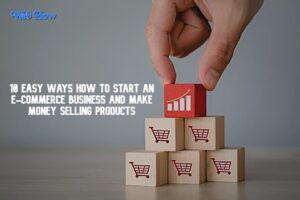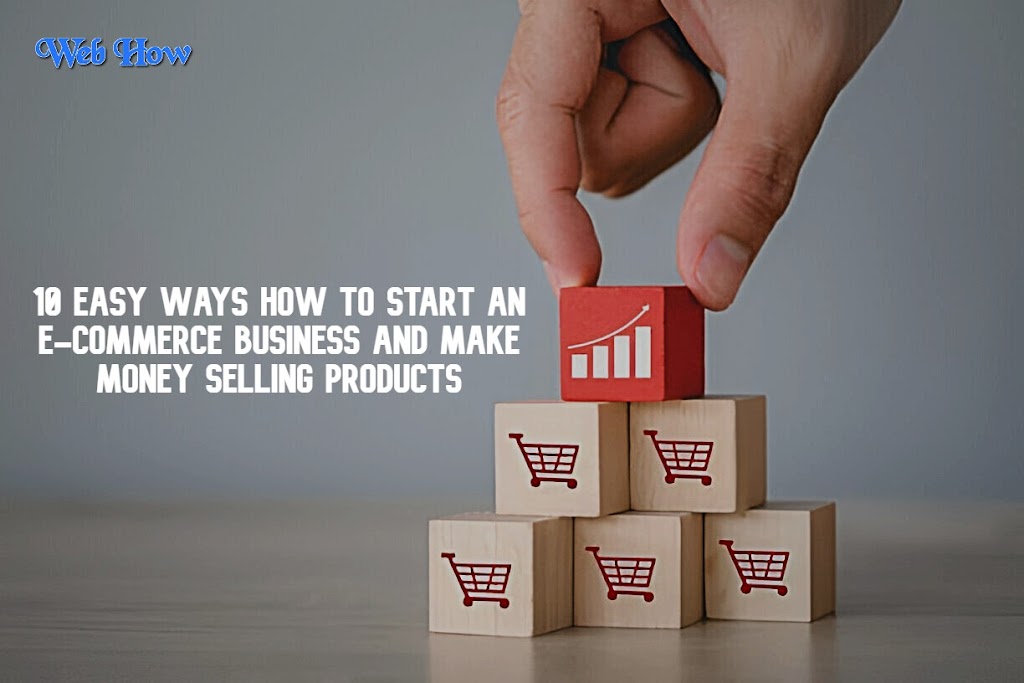10 Easy Ways How to Start an E-commerce Business and Make Money Selling Products
1. Identify a Niche Market
The first step in starting an e-commerce business is identifying a niche market. A niche market is a specific segment of the market that you will target with your products. This might include everything from eco-friendly household items to handcrafted jewelry. Identifying a niche helps you focus your efforts and stand out in a crowded marketplace.
 |
| Online Earning |
Tips for Finding Your Niche:
-
Select a niche: area that you are both informed and passionate about.
-
Market Research: Use tools like Google Trends, Amazon Best Sellers, and social media to identify popular products and market gaps.
-
Competition Analysis: Study your competitors to see what they are doing right and where you can improve.
2. Create a Business Plan
A business plan is a roadmap for your e-commerce business. It outlines your business goals, target market, marketing strategy, and financial projections.If necessary, a well-written business plan can assist you in obtaining funds and maintaining focus.
Components of a Business Plan:
-
Executive Summary: A brief overview of your business.
-
Business Description: Details about your business, including your niche, mission, and vision.
-
Market Analysis: Information about your target market and competitors.
-
Marketing strategy: Your approach to drawing in and keeping clients.
-
Operational Plan: Your business operations, including suppliers, inventory management, and shipping.
-
Financial Plan: Projections of your revenue, expenses, and profitability.
3. Choose an E-commerce Platform
The next step is to choose an e-commerce platform. Your choice of platform will depend on your budget, technical skills, and business needs.BigCommerce, WooCommerce, and Shopify are a few of the well-known e-commerce systems.
Considerations When Choosing a Platform:
-
Ease of Use: Choose a platform that is easy to set up and manage.
-
Customization Options: Look for platforms that allow you to customize your store to fit your brand.
-
Payment Options: Ensure the platform supports multiple payment gateways.
-
SEO Features: Select a platform that offers SEO tools to help your store rank higher in search engine results.
-
Support and Resources: Consider the level of customer support and available resources, such as tutorials and community forums.
4. Source Your Products
Once you have your niche and platform, the next step is to source your products. You can either make your products, buy them wholesale, or use a dropshipping model.
Product Sourcing Options:
-
Manufacturing: If you have a unique product idea, you can manufacture it yourself or find a manufacturer to produce it for you.
-
Wholesale: Purchase products in bulk from wholesalers and resell them at a markup.
-
Dropshipping: Partner with a dropshipping supplier who handles inventory and shipping for you.
5. Set Up Your Online Store
With your products sourced, it’s time to set up your online store. This involves designing your website, creating product listings, and setting up payment and shipping options.
Steps to Set Up Your Store:
-
Select a Domain Name: Make sure your domain name is memorable and pertinent to your company.
-
Design Your Website: Use your e-commerce platform’s tools to design a professional-looking website that reflects your brand.
-
Create Product Listings: Write detailed product descriptions, upload high-quality images, and set competitive prices.
-
Set Up Payment Gateways: Integrate payment options such as credit cards, PayPal, and other payment processors.
-
Configure Shipping Options: Decide on your shipping methods and rates. Consider offering free shipping to attract more customers.
6. Implement a Marketing Strategy
Marketing is crucial for driving traffic to your online store and converting visitors into customers. A comprehensive marketing strategy includes SEO, content marketing, social media marketing, and paid advertising.
Marketing Techniques:
-
Increase organic traffic to your website: by optimizing it for search engines, or SEO. This includes using relevant keywords, creating quality content, and building backlinks.
-
Content Marketing: Create valuable content such as blog posts, videos, and infographics to attract and engage your audience.
-
Social Media Marketing: Use social media platforms like Facebook, Instagram, and Pinterest to promote your products and connect with customers.
-
Email Marketing: Build an email list and send newsletters, promotional offers, and product updates to your subscribers.
-
Paid Advertising: Invest in paid ads on Google, Facebook, and other platforms to reach a larger audience quickly.
7. Focus on Customer Service
Excellent customer service can set your e-commerce business apart from competitors and foster customer loyalty. Ensure that you provide timely and helpful responses to customer inquiries, handle returns and refunds efficiently, and go the extra mile to make your customers happy.
Customer Service Tips:
-
Offer Multiple Contact Options: Provide email, phone, and live chat support.
-
Create an FAQ Page: Address common questions and issues to help customers find answers quickly.
-
Encourage Reviews: Ask satisfied customers to leave reviews and respond to all feedback, both positive and negative.
-
Implement a Loyalty Program: Reward repeat customers with discounts, exclusive offers, or a points-based system.
8. Analyze and Optimize Your Business
Regularly analyzing your business performance is essential for continuous improvement. Use analytics tools to track your website traffic, sales, and customer behavior. Identify areas where you can optimize your operations, marketing efforts, and customer experience.
Key Metrics to Monitor:
-
Traffic Sources: Understand where your visitors are coming from (organic search, social media, paid ads, etc.).
-
Conversion Rate: Track the percentage of visitors who make a purchase.
-
Average Order Value (AOV): Monitor the average amount spent per order.
-
Compute the cost of obtaining a new client: or customer acquisition cost (CAC).
-
Customer Lifetime Value (CLV): Estimate the total revenue a customer generates over their lifetime.
9. Scale Your Business
Once your e-commerce business is up and running, consider strategies to scale it. This could involve expanding your product line, entering new markets, or investing in automation tools.
Scaling Strategies:
-
Expand Product Range: Introduce new products to your existing customers and attract new ones.
-
Explore New Markets: Consider selling internationally or targeting different customer segments.
-
Automate Processes: Use tools and software to automate repetitive tasks such as inventory management, order processing, and email marketing.
-
Partner with Influencers: Collaborate with influencers in your niche to reach a broader audience.
10. Stay Compliant
Make sure your online store abides by all applicable rules and laws. This includes obtaining necessary licenses, collecting sales tax, and adhering to privacy and data protection laws.
Compliance Checklist:
-
Business Licenses: Check if you need any specific licenses to operate your business.
-
Sales Tax: Register for sales tax in states where you have a tax obligation and collect it from customers.
-
Privacy Policy: Create a privacy policy that explains how you collect, use, and protect customer data.
-
Terms and Conditions: Draft terms and conditions outlining the rules and guidelines for using your website.
FAQs: How to Start an E-commerce Business and Make Money Selling Products
1. What is the first step to starting an e-commerce business?
The first step is identifying a niche market. This involves finding a specific segment of the market that you are passionate about and knowledgeable in. Conducting market research and analyzing competitors can help you choose a profitable niche.
2. Why do I need a business plan for my e-commerce store?
Your e-commerce business’s roadmap is provided by your business strategy. It outlines your business goals, target market, marketing strategy, and financial projections. It helps you stay focused and can be essential for securing funding.
3. Which e-commerce platform should I choose?
The best e-commerce platform for you depends on your budget, technical skills, and business needs. Popular platforms include Shopify, WooCommerce, and BigCommerce. Consider factors such as ease of use, customization options, payment gateways, SEO features, and customer support.
4. How can I source products for my e-commerce business?
You can source products by manufacturing them yourself, purchasing them wholesale, or using a dropshipping model. Each method has its pros and cons, so choose the one that best fits your business model and resources.
5. What are the essential steps to set up my online store?
Setting up your online store involves:
-
Choosing a domain name
-
Designing your website
-
Creating product listings
-
Setting up payment gateways
-
Configuring shipping options
6. How do I market my e-commerce store effectively?
Effective marketing strategies include:
-
Search Engine Optimization (SEO)
-
Content marketing
-
Social media marketing
-
Email marketing
-
Paid advertising
These techniques help drive traffic to your store and convert visitors into customers.
7. Why is customer service important for an e-commerce business?
Excellent customer service can differentiate your business from competitors and build customer loyalty. It involves providing timely and helpful responses, efficiently handling returns and refunds, and ensuring a positive shopping experience.
8. What metrics should I monitor to analyze my business performance?
Key metrics to monitor include:
-
Traffic sources
-
Conversion rate
-
Average order value (AOV)
-
Customer acquisition cost (CAC)
-
Customer lifetime value (CLV)
These metrics help you understand your business performance and identify areas for improvement.
9. How can I scale my e-commerce business?
Scaling strategies include:
-
Expanding your product range
-
Exploring new markets
-
Automating processes
-
Partnering with influencers
These strategies can help you reach a broader audience and increase your revenue.
10. What legal requirements must I comply with for my e-commerce business?
Make sure your company abides by all applicable laws and regulations by:
-
Obtaining necessary business licenses
-
registering for sales tax and having clients pay it
-
Creating a privacy policy
-
Drafting terms and conditions for your website
Conclusion
Starting an e-commerce business and making money selling products is a rewarding journey that requires dedication and strategic planning. By following these steps—identifying a niche, creating a business plan, choosing the right platform, sourcing products, setting up your store, implementing marketing strategies, focusing on customer service, analyzing performance, scaling your business, and staying compliant—you can build a successful e-commerce venture. Remember that success doesn’t happen overnight, so stay patient, persistent, and continuously adapt to the changing market landscape. With the right approach, your e-commerce business can thrive and bring you financial success.
